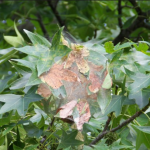Last Updated on January 24, 2022 by Zachary Smith
Fall webworm: mostly occurring in Liquidambar and walnut trees.
In most cases, the aesthetic issue of the unsightly webs is what people want to control. The damage is not usually extensive, but limited to the foliage that is covered by the web. The more webs, the more leaf skeletonizing by the caterpillars. If they are let go to feed out and pupate, there may be higher level of infestation year after year.
Control options:
- Do nothing. Caterpillars will feed out, decend and go into pupa stage and emerge next year as adult moths which will lay eggs for new cycle. Webs will biodegrade with winter weather.
- Mechanical removal only (climber with pole saw and/or pole pruner) will limit unsightly webs and expose caterpillars to natural predators, but may allow survivors to go into pupation and emerge as adult moths the following year. It’s hard to get all web remnants, but is 80% – 90% effective.
- Spray with pesticide only (pyrethrin for contact but no residual (organic program compatible, bio-degrades within 24 hours), or permethrin for more residual). Bt can also be used, but early timing is more of an issue. Spinosad is another organic program pesticide. A strong spray stream can knock webs apart and expose caterpillars to contact pesticide kill, but will leave web remnants hanging.
- Combination mechanical removal with follow up canopy spray. Gets webs and kills all caterpillars.
- Systemic insecticide:
- 1. during active infestation we have to use fast uptake systemic, like Safari with PentraBark basal bark treatment, or better yet ArborJet ACE-jet (acephate) stem injection. This will kill feeding caterpillars, but won’t remove web. Webs will biodegrade in time.
- 2. spring treatment with imidacloprid (soil drench (Merit or Criterion) or stem injection (ArborJet IMA-jet) will deliver pesticide to feeding caterpillars in late summer/fall. Web building will be largely limited.
Our prefered choices;
During active infestation: mechanical removal followed immediately with pyrethrin canopy spray for knockdown.
Preventive: Imidacloprid soil drench in fall or spring for full season control (which also prevents other pest buildup like scale and aphids).
http://www.hgtvgardens.com/pests/fall-webworms
http://www.ipm.ucdavis.edu/PMG/GARDEN/FRUIT/PESTS/fallwebworm.html
—


